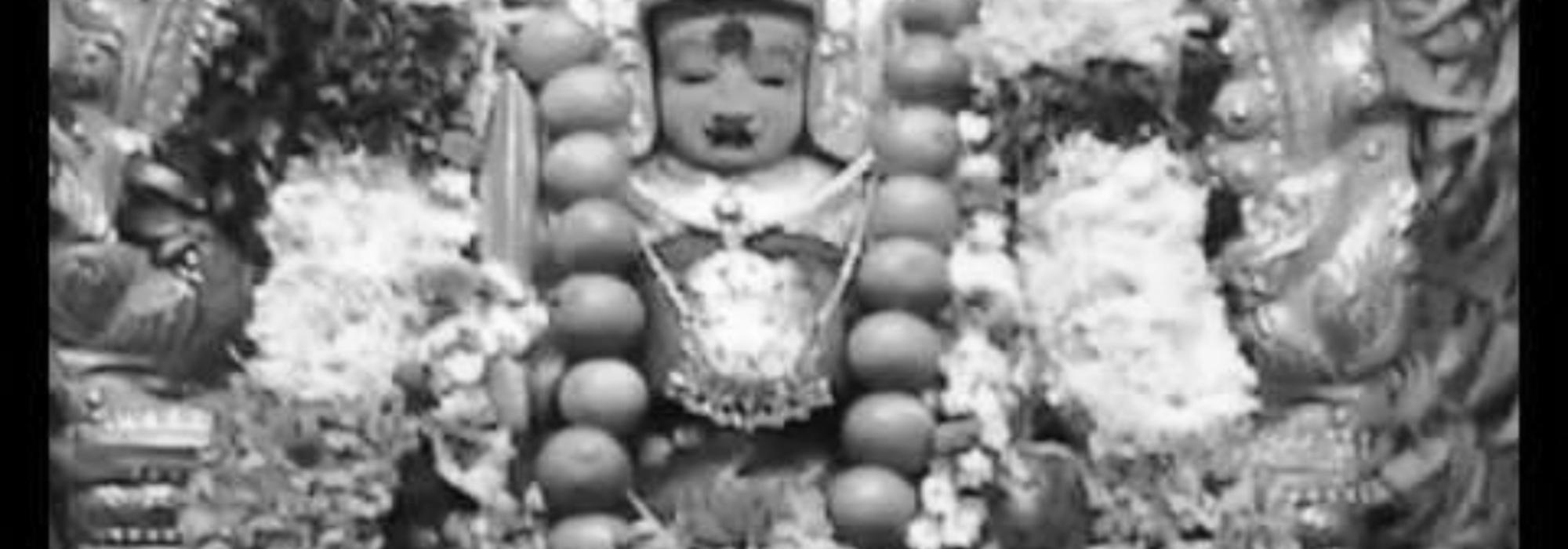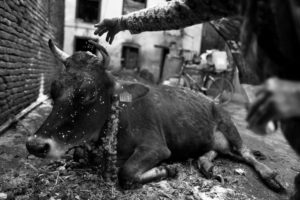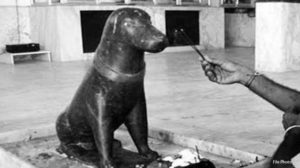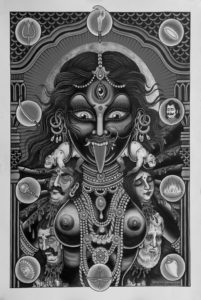The concept of the deity Maramma is a fusion of mythical, folklorish and legendary elements. According to the prevalent belief, a woman of brahmin community burns herself, her husband and children, when she get to know that her husband, being an untouchable, had deceived her and her father, by telling them he was a brahmin youth. Thus the myth of the deity Maramma throws light on the social structure and the caste system of a particular period in India, specially in south lndia. The shrine of the Maramma is an inevitable part of all the villages and towns in India, perhaps in different forms. lt is believed by the people belonging to all strata of society that this is the deity that protects them from epidemics like plague, cholera small pox and other such calamities. Though this goddess is worshiped mainly by the people belonging to lower caste, all the upper class people too participate in the fair and festivals that are celebrated in the name of the goddess. Animal sacrifice is a ritual performed during this time. In ‘Tabbaliyu Neenade Magane’ Bhyrappa describes the rituals and it is interpreted by Hilda the foreigner. In ‘Gruhabhanga’ also, there is the description of the village goddess, who is placated by Nanjamma by offering worship. ‘Daatu’ picturises the legend concerned with the goddess Maramma.
In the distant past an untouchable youth had lied about his caste, learned vedas and had married a brahmin girl. The couple had children too. When, once the mother of the youth came to her son’s house, the truth about the caste of the youth was revealed. The girl did become very angry and felt that her whole life was polluted. As an atonement for the sin of being dishonest and marrying her that was committed by her husband, the girl put dry grass around the house, ignited it, and burnt her husband, children and mother-in-law, and herself also in that fire. From then on she was considered a deity and was being worshiped. ln Tirumalapura of the novel ‘Daatu’, it is believed that the deity Sreenivasa and the deity Maramma are brother and sister. Whenever there is a procession of Maramma, this sister would climb down, salute her big brother and proceed. This was the custom prevalent there. A bull would be reared in the name of Maramma, to be sacrificed on the day of the festival of Maramma. Though animal sacrifice is prohibited by the government these rites are being performed in many places even now.
This festival of Maramma, with animal sacrifice is not limited only to people of lower caste, who are non vegetarians, but vegetarians like brahmins, liṅgayats, goldsmiths, Satanis, Vaishyas too would take offerings of curds rice, jaggery and rice flour sweet, haldi, kumkum and red oleander flowers to worship mother and perform the ritual of putting ‘Sogalakki’, as it is done while sending the daughter to her husband’s house (page: 290-303, ‘Daatu’). As per the
rituals the new idol of the goddess would be taken in the procession, inside the town, along with the bugles, on that day untouchability would not be observed. The bull to be sacrificed would also be in the procession. The bull would also be stopped before every house and the people of every house would pour some water on its body and put some castor oil on its horns and head, smear haldi and kumkum on its face. Before dawn, the procession would reach the shrine and the bull would be tied to the sacrifical pillar. During the period of the sacrifice of the bull, the story of the goddess would be sung, thus the ancient myth got perpetuated through the ages. The song would describe how the untouchable youth had lied, learned vedas and married the brahmin girl, how the youth held the breasts of the brahmin girl, how did he begot children etc. This bull that would be sacrificed is the husband who deceived the girl and the sheep represent her children etc. Some rites follow. Satyabhama, the protagonist of ‘Daatu’ broods upon this myth. What the brhamin girl did, perhaps, was according to her religious faith. Yet, the desire of an intelligent boy to learn vedas, and marry a brahmin girl, was it such a crime? lf the boy did not have the ability how could he learn Vedas’? How did all these rituals start? While the brahmins of the village too have indirectly participated in the sacrifice by offering oil etc. to the bull, are they not morally participating in this? However the myth of Maramma poses two questions. How and why the low caste people made the woman a deity, even though she had burnt the people of their caste, and how could brahmins too accept her as a goddess. Did the brahmins themselves create this story? The myth points at an attempt of truce between the castes, and throws light on how, knowledge hungry young minds were ready to transgress the social barriers of the caste and dared to lie and face punishment if detected.
The census meeting creates historical and contemporary myths about castes. (28-285 ‘Daatu’). This meeting, provokes Satya to brood upon the history behind the age-old myths about castes. The desire to be treated as a brahmin, the conflicts about who is great, either a brahmin or Kṣatriya, then the pacts between the ruler and the brahmin priest, elevating the status of the king to that of the God, all these come before her mind, and in that process the history of castes is revealed. The King had the right to undergo the ceremony of the ritual of sacred thread too (Upanayanam). Shakas, Pahlavas, Yavanas, Hoons, Kushans, Gurjars and Prathiharas - all came and settled in India. Most of them became Hindus bearing the names of lmmadi Nagabhatta, Dharmapala, Bhoja, Jayapala, Viajyapala etc. The ambassador of Greece, Heradotus, had become the devotee of the Indian deity Vasudeva. All these became the kṣatriyas and many became the kings wearing the sacred threads. They were equal to the God Viṣṇu. The king had the authority either to upgrade or downgrade the status of caste, within the limits of Chaturvarna - four varnas - Brahmins would provide proof with the shastras for these changes. People who came from Egypt learned the Vedas and became Nagara brahmins. People from Iran became Chitpavana brahmins. Each group got the status of brahmin. The man in the story of Maramma too had done the same thing, but without the approval of a king or a powerful person. So, he had to pay for it, and this reveals the difference between a myth and history. The census meeting of ‘Daatu’, and the desire of all castes to be included in the list as brahmins, is the repetition of the historical myth in the contemporary social set up. Satya gives a clarion call that she should convert everybody and turn them into brāhmaṇas performing the ‘brahmopadesha’ and making them wear the sacred thread before the fire. But such a large scale event of conversion does not take place. The established myths scarcely give way to the new myths.
The excerpts from ‘Manudharma-shastra’ and ‘Koormapurana’ reveal the rules and rituals that were being observed at that particular period. Besides, they state how the punishment for the same offences was different to the offenders of low castes and high castes. lt is stated that ‘Sudras’ were not free to select pleasant names for themselves. We see, that with the passage of time many of these rules have changed. Harijan’s desire to enter the temple of Sreenivasa in Thirumalapura, is a social myth of - a current myth - the present time and this would, in future, take the form of religious and historical myth. Once, after the entrance of the Harijans into the temple, the temple was ‘washed and the rites of purification were performed by the upper class people.
‘Daatu’, thus presents various phases of myths, legends, rites and rituals, which are not seen so abundantly in any other novel of Bhyrappa. The brevity, precision, and the artistic delineation of these, gives the novel a uniqueness. If myths legends and rituals are used in many novels of Bhyrappa, either to elucidate the motif or to bring the contrast between the past and present values of life, the whole structure of ‘Naayi-Neralu’ is based on the myth of rebirth, and the consequences of the memory of the previous birth in a person, in the present texture of life. Along with the myth of rebirth (birth-death-rebirth an eternal cycle of lite) the doctrine of karma is explored in the central character of the novel, Kshetrapala- Vishweshwara, and his father Acchannayya. All other characters, though closely related to Kshetrapala- Vishweshwara, they are to be passive onlookers and sufferers. Hindus, Buddhist and Jains believe in the theory of rebirth and Karma. These two myths are woven closely in the warp and woof of the novel. The first myth of rebirth and the memory of the previous birth is used in the literary works like ‘Kādambari’ by Bāṇa-bhaṭṭa, in the characters of Puṇḍarīka and Mahāśvetā. Kshetrapala of ‘Nayi-Neralu’, remembers the incidents, parents, the village in which he was born in his previous birth. Thinking the boy is possessed by ghost, many rituals of exorcism of ghost is also performed. Along with the myth of rebirth and the memory of the past, another myth that dog is the symbol of our past deeds, is also woven in the text. From his childhood till he goes to jail, a dog is always the companion of Kshetrapala-Vishweshwara. The dog representing the deeds of man is a myth from ‘Mahabharatha’. In the ‘Svargārohaṇaparva’ a dog follows Dharmaraya till the end of his journey. The doctrine of Karma is expounded chiefly in two situations in the novel. In both the situations the rituals, and prevalent beliefs are delineated.
Kshetrapala’s birth in the family of Tirumala Jois of Gangapura has a mysterious background. The child was born to the couple after Lakshmidevamma had her menopause. Tirumala Jois already had grand children and his youngest son was eighteen years old. Lakshmidevamma, who was healthy in pregnancy, as soon as the child was born, shirked horribly, became unconscious and died. The cause of the birth of this child is attributed to the ‘daana’ of a big ash-gourd and an iron frying pan full of gingelly oil, Tirumala Jois had taken on the occasion of Thipegowda’s funeral rites. Thirumala Jois, as the chief priest, to save the honour of brahmins, accepted the challenge thrown by Kenchegowda, and accepted those daanas. He did hope he would ward off the bad effect of this by chanting one thousand and eight gayatri mantras and performing Navagraha homa. Two months after this incident, Tirumala Jois’ wife became pregnant.
This background of the birth of Kshetrapala, evokes the myths and rituals that were existing in the society at a certain point of time. These beliefs and rituals still exist in our society. Daana of ash gourd and an iron frying pan filled with oil is still considered an evil daana (durdaana). Through the character of Kshetrapala the myth of birth, death and rebirth is concretised, and the consequences of Karma in the characters of Thirumala Jois and Acchannayya.
When Kshetrapala insisted that he was married and his wife’s name was Venkamma, Thirumala Jois’s sons think of exorcising the ghost that has possessed Kshetrapala and in this context, the cruel rituals of exorcism is depicted. Bhaskarachari is the famous exorcist, who has gone to Malayalam speaking region to learn the rituals of black-magic, witchcraft and worship of chowdi, a folk deity.
The rites of exorcism would take place in a cemetery at the midnight of the New Moon. The person who is supposed to be possessed would not be given boiled food. In the cemetery an idol of chowdi made of mud would be installed on a high pedestal, with its two knees bent, forearms spread, mouth open so as the pointed canine teeth are seen and the tongue spread. The whole body of the idol would be blood red, with the smearing of kumkum. Around the idol eight pegs would be stuck, and by binding them and reeling the raw thread around, the rite of general charm to keep off all evil would be performed. Near every peg three lemons would be out and kept. On both the sides of the chowdi, torches with flames blazing and one big ash pumpkin would be cut into two halves and kept there, on both the sides of the idol. Two cocks were kept inside the basket woven with toddy palm leaves. These were the materials required to exorcise. This process consists of questioning the possessed and offering the beheaded cocks to chowdi. The possessed would be beaten with the broom made of tamarind twigs. If this wouldn't work, severe punishments like branding with the hot iron rod would follow (page 13-15 ‘Nayi~Neralu). When none of these rituals and punishments have any effect on Kshetrapala, Bhaskarachari himself said that the ghost must be either Jademuni or ‘Brahmapishacha’, which could not be controlled by him. This Jademuni and brahmarakshasa are considered very tough ghosts, according to the popular belief.
When the phenomena of sweet milk oozing from the Neem tree occured in Jogihalli, it was interpreted as a miracle of the village-goddess. But Acchuta, the college educated boy, son of Kshetrapala-Vishweshwara, did not agree with the faith of the villagers, and with a sense of quest and doubt wanted to test this to the core. The villagers, naturally believed that the sweet milk was the breast milk of the goddess mother. When Acchuta, without being noticed by anybody, put a knife to the tree, where the milk was oozing out, the milk stopped flowing. The reason for this stopping of the milk-like substance in the neem tree, is explained scientifically by Acchuta’s professor. But this act of Acchuta caused horror in the village. In this context, the author has put side by side, the scientific explanation, religious belief and the priest of the Goddess being possessed by the deity. No body knows how did the priest came to know of Acchuta's act. Kempa, the priest oi the Goddess Kempamma was possessed by the deity, and with all the rituals, he was present before the house of Acchannayya. The description of the priest is like this: Beating the drum wildly, haldi and kumkum smeared on his forehead cheeks and chest, scattered hung hair, wearing a yellow sari, biting his teeth, the priest came to the street, and directly rushed towards Acchannayya’s house. Two people held the burning torches and an oil-miller held the pot of castor oil and followed the priest. Actually they were running behind the priest who was moving rapidly. The priest then and there settled the matter and said Venkamma was an auspicious woman, whose husband is alive, she could worship the Goddess. But the Goddess’ wrath was against Acchuta. He told before the villagers, that Acchuta had wounded the tree with the knife, and the milk had stopped. if he did not accept his crime and beg for pardon, the Goddess would ravage the whole house.
Ancient myth of being possessed by Gods and Goddesses and spirits, the rituals observed are used here to depict the conflict between the old beliefs and scientific thinking. The possessed priests answering the questions of the people is a tradition, a custom from the period of the Oracle of Delphi. Chinua Achibe’s 'Things fall apart’, picturises priests possessed by the spirit, walking through the villages at night. These are the myths, it seems, that prevail among the villages, urban areas and the tribals too.


















































